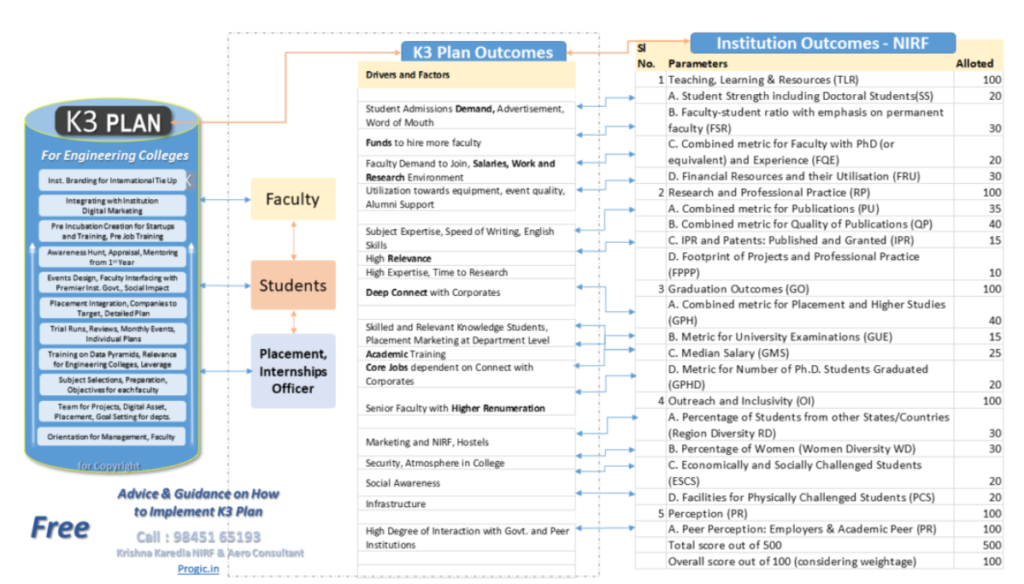NIRF is here to stay. There is no avoiding or bypass.
K3 Plan is for taking you to top 100 of NIRF and beyond.
If your institution implements this sustainable plan and knows how to score in the NIRF Rank system, there is no looking back!

In the above Pic you will see we have the K3 Plan on the left, and on the right Outcomes which are measured by NIRF Rank using point system.
In between, is the question how does K3 Plan bridge the Gap?
Firstly, the NIRF Factors are outcomes of an institution performance in the past year.
And, outcomes are the result of actions or a series of actions which occur and happen in an Engineering Institution.
This is not to say that if an institution has not scored a rank, it is not doing well. It is just that it is not doing enough.
Every Engineering Institution in India is doing its bit to stay competitive.
And, all institutions are taking NIRF seriously.
NIRF is on top of their list. And, rightly so.
Mine, and other experts suggest, take NIRF seriously, it is good for the institution.
All indications point to the reality that NIRF will become all important over other regulations and in due course, accreditations will become simplified, with less room or no room for discretion.
The unique feature of NIRF Rank is that it is completely verifiable. So, no escaping from that. So, all that is submitted has to be correct, as getting caught can be costly.
However, there is some shortcomings in college’s approach to analyzing NIRF.
Many colleges I have seen, are doing the following.
Take each factor, check out the marks / points allotted and focus on those factors.
But, we need to note, and this is important, NIRF factors are all outcomes of a series of actions done earlier.
Let us look at the factors.
If look at the factors closely, you will see varying marks for different factors. The student strength is given first place, and a high score value. A too low score is going to put the institution down. But, what is a good score?
I believe and this is my estimate, based on discussions experts and my own analysis, roughly 800-1500 students is a good score.
But, the next ranking factor itself corrects any anomalies in the score of the first factor.
That is faculty student ratio.
While increasing number of students it admits, institution has to ensure it can keep the faculty strength up.
Similarly, while the number of publications gets a good score for the institution, the quality of publications seeks to correct runaway publications.
Projects get a low score comparatively, but colleges have to note that projects are the basis for internships, jobs, higher education, median salary which carry a high score.
So, do not neglect one just because, it carries a low score.
One anomaly in the ranking factors is that startups do not find a place. This is an anomaly as the Prime Minister himself has called for “Startup India Standup India”. Just watch, it will appear soon in the NIRF factors, so better get prepared.
Overall, the NIRF ranking system emphasis is on Research, and Core Jobs. Additional emphasis on Patentable research and Core jobs.
Patents carry a good score, while core jobs is covered by median salary, a direct indicator of core jobs.
One factor, which college management are overseeing is the Ph.D. students. The NIRF systems lays heavy emphasis on specialization. Good institution focus on research, excellent institution of relevance. More relevant your research, more the collateral benefits.
Given the number of factors Principal and Managements have to face, things usually happen in a non optimized manner in a college. My request is do not take it as criticism. It is a fact of institution life.
It is an everyday job to keep things in perspective.
This is precisely the primary objective of K3 Plan.
With a cleverly designed systematic Plan, beginning with subject matter specialization, leading to extremely high degree of relevance to the Industry and Technology Trends worldwide the right implementation of K3 Plan will not only put the institution on top of the NIRF charts but also be a trendsetter. Admissions, including international admissions will become a reality.
If your institution has become an autonomous institution or not, K3 Plan will add to all the efforts the institution is undertaking currently.
Moreover, the Plan is free to implement, and does not come with software or any other baggage.
Further, because of the sync with the current, all participants, everybody faculty, students, and placement officers are all highly motivated.

In the above picture you will notice that on the extreme right you have the NIRF ranking factors on the left you have K3, and in the middle you have the three entities – faculty, students and placement officers who will be driving the K3. There is no external team which is working parallelly!!
Very importantly, the Plan is contagious.
When one faculty sees that his colleague is going ahead, others will be motivated to catch up.
The Plan gives complete control to the management, thereby ensuring that culture and competitive priorities are met.
Any plan a college implements, has to have one feature, Sustainability. A complex plan is hard to sustain, whereas a simple, I call it common sense plan is easy to implement and grows organically.
The NIRF system, is a boon to Engineering Education in India.
The Govt., Ministry of Human Resource, has made the Policy. Are we Engineers, Ph.Ds., and Managements ready to lead?

